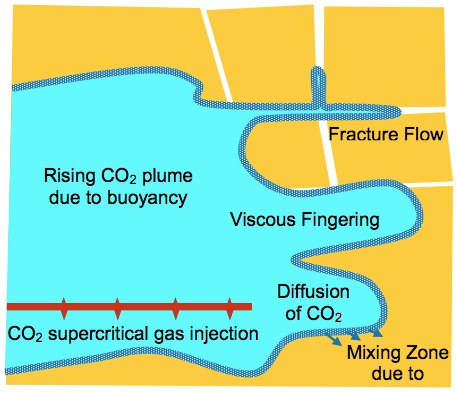The accuracy of flow models depends mainly on the quality of the input parameters and their capability in handling the following flow and transport processes that control the spread of CO2Carbon dioxide in the storage(CO2) A process for retaining captured CO2, so that it does not reach the atmosphere medium (Metz et al., 2005):
- fluid flow (migrationThe movement of fluids in reservoir rocks) in response to pressure gradients created by the injectionThe process of using pressure to force fluids down wells process,
- fluid flow in response to natural hydraulic gradients,
- buoyancyTendency of a fluid or solid to rise through a fluid of higher density caused by the density differences between CO2Carbon dioxide and formationA body of rock of considerable extent with distinctive characteristics that allow geologists to map, describe, and name it fluids,
- diffusion,
- dispersion and fingering caused by formationA body of rock of considerable extent with distinctive characteristics that allow geologists to map, describe, and name it heterogeneities and mobility contrast between CO2Carbon dioxide and formationA body of rock of considerable extent with distinctive characteristics that allow geologists to map, describe, and name it fluid,
- dissolution into the formationA body of rock of considerable extent with distinctive characteristics that allow geologists to map, describe, and name it fluid,
- mineralisationIs a natural form of geologically storing CO2Carbon dioxide by the very slow reaction between CO2Carbon dioxide and naturally occurring minerals, such as magnesium silicate, to form the corresponding mineral carbonateNatural minerals (e.g. calcite, dolomite, siderite, limestone) composed of various anions bonded to a CO32- cation,
- pore spaceSpace between rock or sediment grains that can contain fluids (relative permeabilityAbility to flow or transmit fluids through a porous solid such as rock) trapping(CO2Carbon dioxide) ContainmentRestriction of the movement of a fluid to a designated volume (e.g. reservoir) or immobilisation of CO2Carbon dioxide, there are four main trapping mechanisms: structural or stratigraphicThe order and relative position of geological strata trapping; residual CO2Carbon dioxide trapping (capillary trappingImmobilisation of a fraction of in-situ fluids by capillary forces) by capillary forces; solubility trappingA process in which fluids are retained by dissolution in liquids naturally present by dissolution of CO2Carbon dioxide in resident formationA body of rock of considerable extent with distinctive characteristics that allow geologists to map, describe, and name it fluids forming a non-buoyant fluid; and mineral trapping where CO2Carbon dioxide is absorbed by solid minerals present in the storage(CO2Carbon dioxide) A process for retaining captured CO2Carbon dioxide, so that it does not reach the atmosphereThe layer of gases surrounding the earth; the gases are mainly nitrogen (78%) and oxygen (around 21%) volume,
- adsorptionThe adhesion of atoms, ions, or molecules from a gas, liquid, or dissolved solid to a surface of CO2Carbon dioxide onto organic material.
Some of the main flow processes of CO2Carbon dioxide are illustrated by Iding and Ringrose, 20092009 - M. Iding and P. RingroseEvaluating the impact of fractures on the long-term performance of the In Salah CO2 storage sitesee more in Fig. 3-1.
| 
Fig. 3-1: Main flow and CO2Carbon dioxide transport mechanisms (Iding and Ringrose, 20092009 - M. Iding and P. RingroseEvaluating the impact of fractures on the long-term performance of the In Salah CO2 storage sitesee more). |
When modelling reservoirA subsurface body of rock with sufficient porosityMeasure for the amount of pore spaceSpace between rock or sediment grains that can contain fluids in a rock and permeabilityAbility to flow or transmit fluids through a porous solid such as rock to store and transmit fluids behaviour, it is important to consider and adequately represent the different geological formations within the storage(CO2Carbon dioxide) A process for retaining captured CO2Carbon dioxide, so that it does not reach the atmosphereThe layer of gases surrounding the earth; the gases are mainly nitrogen (78%) and oxygen (around 21%) system and their characteristics.